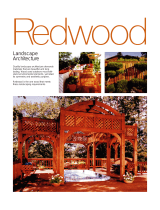Page is loading ...

Douglas Fir Lumber Fact Sheet
Classification: Western Softwood, not a true Fir. It is its own species most closely related to Hemlocks. It is also
commonly referred to as “Larch” in the Western US. The scientific name is Pseudotsuga menziesii.
Growth Range: One of the most dominant and sustainable species in the Northwestern Forests of the Pacific
Coastal states, Rocky Mountain States, and British Columbia. Like WRC, it’s a sustainable product that has a
government mandated replanting rate of five new trees planted to every one mature tree cut.
Tree Dimensions: The mature trees can reach heights exceeding 250’ tall, and diameters over 6’ wide.
Grain Structure: Fairly straight grained with slight ripples in the pattern. The grain pattern coloration
alternates from yellow to reddish brown, giving the lumber a yellow-orange color similar to Western Red
Cedar. Both species take oil-based stain similarly and are almost indistinguishable. Both are rough sawn lumber
and it is not dimensional lumber (meaning that we are using full 6x6s, 8x8s, etc).
Fasteners Retention Properties: Holds fasteners such as nails and screws well, similar to WRC, due to its high
specific gravity (the scale used to judge a material’s density and flexibility).
Shrinkage of Green Lumber: Slightly less shrinkage while achieving equilibrium with its dryer surroundings
than Western Red Cedar. Douglas Fir beams are said to be less likely to check than WRC beams of the same
size, due to its higher density and lower rates of shrinkage. Even so, set your customer’s expectations.
Weight: Slightly heavier/ denser than Western Red Cedar. Air dried Douglas Fir lumber with a moisture
content of approximately 12% weighs roughly 30-34 lbs per cubic foot, while WRC lumber under the same
parameters weights roughly 22-23 lbs per cubic foot. Neither are as dense or heavy as Alaskan Cypress.
Dimensional Stability: High, meaning that it is less prone to warping, twisting, or checking, similar to WRC. This
also makes it an ideal use in areas subject to high winds, storms, and earthquakes, since Douglas Fir lumber’s
dimensional stability and inherent tensile strength make it less likely to crack or break under intense strain.
Rot and Decay Resistance: Classified as having a “moderate range” of rot and decay resistant properties and is
therefore less resistance to rot and decay than WRC with its natural tannic acids. Lawn Master will not install
Douglas Fir posts in the ground because it is not rated for ground contact, so upgrades to WRC posts or
installation on concrete slabs and/or footers is required. For applications above ground level where contact
with ground water is not an issue, Douglas first is a great option for outdoor use.
Insect Resistance: Slightly more susceptible to insect damage than WRC because it lacks the natural tannic
acids found within WRC. Treating the lumber with an oil-based stain will help in this regard.
Engineering: Douglas Fir has existing span charts and most cities are familiar with it as a building material (in
some cases, more than they are with WRC). Keep the weight in mind because some larger structures may
exceed the weight limit for a 3.5” thick slab. These will be flagged on the price sheet. Same wind speed ratings.
Lawn Master Models Offered: All of them except the Standard Pergola.
Sources:
https://www.realcedar.com/why-western-red-cedar/natural-characteristics/
http://www.wwpa.org/western-lumber/species/douglas-fir
https://www.uslumber.com/MainSite/Store1/Store/CategoryHome/1684
https://www.wood-database.com/douglas-fir/
https://bearcreeklumber.com/species/douglasfir.html
/


